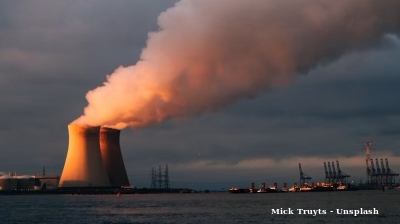LONG READ: Construction work on Belarus’ Ostrovets nuclear power station almost complete, but is it safe?

Construction work at Belarus’ Ostrovets nuclear power plant (NPP) is coming to an end, which expected to come online in July. But the facility remains a bone of contention with its neighbours, who simply don't trust the Belarusians to run a nuclear facility without something going wrong. Is Ostrovets really safe?
Minsk is keen on the plant, which will radically alter the small republic’s power profile. For much of the last two years Minsk has been dogged by the Kremlin, as it has revamped its energy tax regime and in effect has cut Minsk off from hundreds of millions of dollars of subsidies. Moscow has not been above using this largesse as a political weapon to get its way and the power from Ostrovets (known as Astravets to the Russians) will enable Minsk to remove one of Moscow’s most power levers.
At the same time Russia has been instrumental in getting the project off the ground. The technology is from the state-owned nuclear power company Rosatom, which, as bne IntelliNews has reported, has massively ramped up its nuclear technology exports in the last few years. What makes Rosatom so attractive to work with it that is also provides the financing for the c.$10bn price ticket for the plant. Currently Rosatom has some 40 international projects either completed or under construction, according to the company, making it the market leader in international nuclear power technology.
Nervous neighbours
The legacy of the Chernobyl disaster in 1986 has created a sensitivity to Russian nuclear power that needs to be addressed.
Neighbouring Lithuania has voiced the most vocal objections, as the reactor is being built only 45km from its capital Vilnius. Lithuanian President Gitanas Nauseda called for measures to “prevent countries with unsafe nuclear power plants” from exporting electricity to Lithuania, in a barb that was clearly directed at Belarus. And the government in Vilnius has been on a campaign to feed the fears that dog nuclear power projects, especially in Eastern Europe.
"The plant is being built in breach of safety standards, including the UN’s Espoo and Aarhus conventions," Arvydas Sekmokas, Lithuania’s former energy minister, told Euronews."Minsk has disregarded International Atomic Energy Agency (IAEA) recommendations made after the Fukushima disaster that plants should not be built within 100 kilometres of major population centres."
The Espoo Convention states that all countries must consult their neighbours on the potential cross-border environmental impact of a nuclear project.
But so far there is only a draft assessment from Espoo and it needs to be adopted as a final version before it can enter into legal force. Moreover, the draft doesn't say that the plant is being built in breach of the convention.
“The environmental impact assessment [EIA] documentation of Belarus on the Ostrovets nuclear power plant includes information that sufficiently addresses issues referred to in technical and scientific questions related specifically to the Ostrovets site,” the draft assessment says and goes on to state that Belarus has complied with all the requests for information demanded by Espoo, but concludes more work still needs to done before a final decision can be made.
While the assessment found nothing wrong with the location of the Ostrovets site, it did say that Belarus has not provided enough information on alternative sites, and that was, the draft states, in breach of the Convention.
The Espoo assessment still needs to be finalised but even if it concludes that Belarus is in breach of the convention, as there is no bilateral agreement between Belarus and Lithuania governing the implementation of the Espoo Convention, any conclusions it draws are not binding on Belarus.
That hasn't stopped Vilnius from playing up the issue. To bring home the danger Lithuania has bought half a million iodine tablets and held drills to prepare for a nuclear emergency last autumn that included the mock evacuation of half a million people from the capital in the event of a major meltdown.
Safety first
The old RBMK class of graphite-moderated nuclear reactor designed and used in the Soviet Union is being phased out. (There are current 10 RBMK reactors still in operation.) For example, the construction of a new RBMK reactor on the shores of the Sea of Azov in Ukraine was immediately stopped half way through after Chernobyl blew up and the decaying superstructure (without the reactor or fuel rods) stands in a field there to this day, where it has been used as the venue for the Kazantip summer musical festivals.
More specifically, Ostrovets detractors have claimed that the plant does not meet EU safety standards or regulatory norms.
The plant is based on pressurized water reactor (PWR) technology, which are used in two thirds of all nuclear power stations in the world. In the 65 years the PWR reactors have been in use IAEA has never reported an accident or a single loss of life associated with them.
PWRs have come to dominate the business, which has gone through several generations of development. Russia claims that its water-water energetic reactor (VVER, using its Russian acronym), with the 1200-MW version being the latest generation of this technology, and the one being installed in the Belarusian facility, is the best in the business.
“VVER-1200 belongs to the latest generation of reactors which meet the strictest post-Fukushima requirements,” Rosatom says. “Indeed, it’s now the most common new build design in the world, with 36 power units being selected by utilities and watchdogs in 12 countries including Finland, Hungary, China, India and Turkey.”
Rosatom’s VVER-1200 reactor is fully certified by the European Utility Requirements (EUR) organisation and both the European Nuclear Safety Regulators Group (ENSREG), an independent, expert advisory group created by the European Commission, and the IAEA have acknowledged the safety features of the VVER-1200 reactor series fully comply with European requirements.
“Its core design has [a] state-of-the-art safety system, including advanced cooling reliability and built-in passive safety systems with a 72-hour grace period that requires no operator intervention after shutdown. This model falls under Generation 3+ reactors designed precisely on the basis of lessons learned in the aftermath of the Fukushima disaster,” says Alexander Uvarov, a Russian nuclear expert and the editor-in-chief of nuclear news site AtomInfo.ru.
International inspectors double checking from the start
The construction of Ostrovets has been under international supervision since the beginning, as the Belarusians are as keen as the Lithuanians to make sure the reactor is as safe to use as possible. Although the city of Pripyat, where the Chernobyl reactor was located, was in Ukraine, it was Belarus’ southern regions that were in the path of the deadly radioactive cloud and took the brunt of the damage.
The project has been thoroughly reviewed by international inspectors and in 2016 the IAEA’s then Director-General, Yukiya Amano, called Belarus one of the most advanced nuclear “newcomer countries” in the world.
“The IAEA has worked closely with Belarus on all aspects of this major project and will continue to offer every assistance,” Amano said during an inspection trip to the site in 2016.
The IAEA made various evaluations of the project’s safety in 2012 and 2016 as well as assessing the danger from catastrophic floods and earthquakes (a Site and External Events Design study) in 2017. Most recently Belarus voluntarily agreed to conduct EU nuclear safety ‘stress-tests’ in 2017 and 2018 and to allow the results to be peer-reviewed by the EU nuclear safety body ENSREG, which confirmed the plant could withstand the most extreme natural calamities.
Throughout the construction of the plant the project has been open to inspection and hundreds of journalists and experts have visited the facility since it was opened to visitors in December 2015 and the progress showcased at the annual Atomexpo-Belarus in Minsk.
Even the Lithuanians have been invited. A Lithuanian delegation visited the plant on July 9, 2018 as part of a delegation of EU and non-EU experts, which concluded the Belarusian nuclear power plant has "generally” met the requirements of a European Union "stress test" designed to avert repeats of the 2011 Fukushima disaster, Euronews reports. Yet the thorniest issue of the site — it is less than 50 kilometres from the Lithuanian capital — remains an point of conflict and controversy – despite the fact that there is no regulation or recommendation from IAEA banning nuclear power plants within a specified radius from densely populated areas. The 1994 IAEA Convention on Nuclear Safety (CNS), which is the current and most up-to-date legally binding set of regulations in this area, does not specify any requirements regarding distances between nuclear power plants and cities.
Most recently, in August 2019 the IAEA sent a 15-member Pre-Operational Safety Review Team, composed of IAEA officials and experts from Armenia, Belgium, Brazil, France, the Netherlands, Russia, Slovakia and the US, on an 18-day mission to assist in strengthening the plant’s operational safety as the construction moved into its final phases.
Black swan risks
Still, Lithuania remains unconvinced and points to the “Gudogai earthquake” in 1908 as one of their main concerns that reportedly reached 7 on the Richter scale, located on a farm close to the site of the Ostrovets NPP.
But questions hang over this incident. The town's railway and local churches were undamaged by the earthquake that was only reported in the local paper based on the second-hand reports of two witnesses; nor were there any reports from the nearby village of Ostrovets, which is only 6km away, according to Rosatom.
Seismic studies were started in the area in 1965 and there have been earthquakes, but of minor strength, according to the records. Moreover, Lithuania didn't factor in earthquake risk when building its own Interim Spent Fuel Storage Facility on the Belarusian border 24km away from the reported epicentre of the Gudogai earthquake.
But because of lingering doubts over the safety of the plant, in October 2019 Lithuania’s president called for the EU to block the completion of the plant in the name of Lithuania’s national interest and to preserve Belarus’ sovereignty, as allowing a Russian-built NPP would make the republic more dependent than ever on its larger eastern neighbour.
The last argument has been negated to some extent after Minsk and Moscow locked horns over Russian energy imports last year, making it even more imperative for Minsk to reduce its dependence on Russian hydrocarbon imports. The Ostrovets NPP is anticipated to result in Belarus’ gas imports from Russia – its main source of energy – falling by 5bn cubic metres annually.
The c$9bn Belarus has borrowed from Russia to pay for the plant could in theory be used as a new lever, but the loan was made on commercial terms and can be simply refinanced on the international capital markets. The amount is equivalent to some 10% of the republic’s total external debt, so while not insignificant, it is not enormous either. And the plant comes with a long-term service contract provided by Rosatom. But as there are several other international companies from Europe, US and China offering both services and nuclear fuel, Belarus could simply switch vendor if Russia tried to withhold fuel supplies, for example.
Business logic
In addition to meeting its own energy needs, Minsk is also hoping to make some money from power exports to its neighbours. Lithuania used to have its own NPP at Ignalina, but that was shut down in 2009 as it, unlike Ostrovets, used the old Soviet RBMK design.
The upshot is Lithuania has turned to natural gas to replace nuclear power, which has also pushed up its CO2 emissions by 13%, according to official figures. The neighbouring countries of Estonia and Poland suffer from similar problems and Poland in particular remains heavily dependent on coal-fired power stations, making them amongst the most carbon-intensive energy producers in the EU, emitting over 900 grams per KWh of consumed electricity (twice that of the UK and nine times more than France).
Without the Lithuanian ban on imports and transits, the Belarus NPP could help reduce CO2 emissions by about 2mn tonnes per year (tpy) by replacing the most polluting and environmentally harmful coal output in Poland and Estonia.
Lithuania says that Ostrovets can be weaponised and used as a geo-political tool to increase the region’s dependency on Russian energy. To avoid that, Vilnius has been lobbying the EU to disconnect the former Warsaw Pact countries from the Soviet-era grid and build a new electrical “Iron Curtain”. However, Brussels has baulked at the billions of euros remaking the regional power grid would cost and the US has remained deaf to Vilnius’ entreaties for help and pressure on Minsk. European leaders are just as worried about maintaining energy security for their countries as they are of Russian machinations, as Germany’s insistence on pursuing the controversial Nord Stream 2 gas pipeline has shown.
If Russia were able to turn off the lights at will in the capital of a NATO member such as Lithuania, that would be a legitimate security concern, but the amount of power Lithuania would import doesn't make that possible.
According to Litgrid, the Lithuanian electricity transmission system operator, as of 1 January 2020, Lithuania had almost 3.6 GW of net installed power generation capacity of which, about 2 GW was natural gas. The LitPol and Nordbalt interconnection links with Poland and Northern Europe add 1.2 GW resulting in 3.2 GW of perfectly dispatchable power supply, independent from either Belarus and Russia.
The maximum capacity demand in Lithuania at peak load in winter is estimated to be between 1.8 and 2.3 GW, which means that Lithuania can meet its entire demand with domestically sourced power and then some. Building Astravets gives Russia no extra leverage over Lithuania.
And importing power will reduce costs. Lithuania spent approximately €500mn on building the Klaipeda floating LNG (FLNG) terminal launched in 2014, but as electricity prices remain depressed, natural gas is still too expensive a fuel to make using LNG, imported from Norway and the US, a viable fuel. It is cheaper to import power and in 2019 Lithuania imported 80% of its electricity.
The low costs of power go some way to explaining the resistance to Ostrovets, which will become yet another source of cheap power in the republic. In order to sustain the LNG imports the government has already resorted to mandatory purchase orders of LNG-based power for utilities as a way of maintaining its LNG infrastructure, which the government sees as part of its energy security setup.
Features

Project Matador marks new South Korea-US nuclear collaboration
Fermi America, a private energy developer in the United States, is moving ahead with what could become one of the most significant privately financed clean energy projects globally.

CEE needs a new growth model as FDI plunges
wiiw economist Richard Grieveson says the CEE region’s long-standing model of attracting FDI through low labour costs no longer works.
KSE: Ukraine is facing a $53bn budget shortfall, but economy is stable for now
Ukraine is in urgent need of additional financing from partners as the continuation of the war drives up defence spending and reconstruction needs, jeopardizes budget financing, weighs on the balance of payments, and slows economic growth.

PANNIER: Ruling family’s ‘palace in the sky’ cruel sight for Turkmenistan’s poor souls down below
Photos posted of renovated Boeing by US makeover manager offer further insight into "ultra-luxurious" world enjoyed by Berdimuhamedovs.



